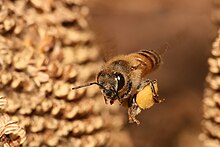Honeybee
| Honey bees Temporal range: Oligocene–Recent |
|
|---|---|
 |
|
| European honey bee carrying pollen back to the hive | |
| Scientific classification | |
| Kingdom: | Animalia |
| Phylum: | Arthropoda |
| Class: | Insecta |
| Order: | Hymenoptera |
| Family: | Apidae |
| Subfamily: | Apinae |
| Tribe: |
Apini Latreille, 1802 |
| Genus: |
Apis Linnaeus, 1758 |
| Species | |
|
|
A honey bee (or honeybee) is any bee member of the genus Apis, primarily distinguished by the production and storage of honey and the construction of , colonial nests from wax. Currently, only seven species of honey bee are recognized, with a total of 44 subspecies, though historically, from six to eleven species have been recognized. The best known honey bee is the Western honey bee which has been domesticated for honey production and crop pollination. Honey bees represent only a small fraction of the roughly 20,000 known species of bees. Some other types of related bees produce and store honey, including the stingless honey bees, but only members of the genus Apis are true honey bees. The study of bees including honey bees is known as melittology.
The genus name Apis is Latin for "bee".
Although modern dictionaries may refer to Apis as either honey bee or honeybee, entomologist Robert Snodgrass asserts that correct usage is to use two words, i.e. honey bee, as it is a kind or type of bee, whereas it is incorrect to run the two words together as in dragonfly or butterfly, because the latter are not flies. Honey bee, not honeybee, is the listed common name in the Integrated Taxonomic Information System, the Entomological Society of America Common Names of Insects Database, and the Tree of Life Web Project. Nonetheless, compounds gradually solidify in the orthography of natural languages in ways that do not always comply with prescription.
...
Wikipedia
